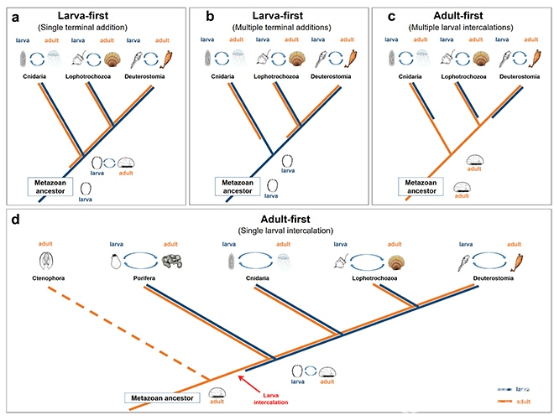
Our marine larvae evolution study was published in Nature Ecology & Evolution
On March 16, 2020, we published the latest research "Evolutionary transcriptomics of metazoan biphasic life cycle supports a single intercalation origin of metazoan larvae" in Nature Ecology & Evolution. This research is another important landmark of our team following the scallop genome projects (Nature Ecology & Evolution, 2017 cover paper; Nature Communications, 2017).
How metazoan larvae originated and evolved has puzzled researchers for centuries and is currently a major enigma in animal evolution and biology. At least 15 metazoan phyla exhibit a biphasic life cycle, alternating between a small, pelagic larva and a larger-bodied, benthic adult. Biphasic life cycle is central to metazoan evolution, by providing animals with the greatest developmental and morphological plasticity for versatile ecological adaptation and is considered as a major event in the evolution of animal life cycle. It is also one of the key elements driving the high diversity and prosperity of marine animal taxa. Therefore, resolving the evolution of the origin of marine larvae is of great scientific value and significance to deeply understand the macroevolutionary mechanisms of animal life cycle.
Due to the lack of complete fossil records and molecular data, the origin of marine larvae has been debated in the international academic community for a century. At present, there are mainly two kinds of model hypotheses: (1) the “larva-first” hypothesis, which suggests that the larval evolutionary origin predates the adult stage, and that the biphasic life cycle arose through single or multiple rounds of adult-stage addition; (2) the “adult-first” hypothesis, which suggests that the larval origin is later than the adult stage, and that the larval stage arises by multiple insertions in the late evolutionary process. Relatively speaking, the "larva-first" hypothesis has been more widely accepted by the international evolutionary development community.
By analyzing the whole development cycle transcriptome data from a variety of representative marine animal taxa, the research team skillfully applied the transcriptome age index (TAI) analysis method to deduce the evolutionary origin history of larvae. It is surprising to find that the larval stage (compared with the adult stage) shows a more "younger" expression profile throughout the life cycle, and is common in metazoan lineages. The results support that the evolutionary origin of larval stage is later than that of adult stage, thus against the "larva-first" hypothesis model that has been dominant in academic community for a long time. However, different from current “adult-first” model that assumed multiple, independent larval intercalations in major animal lineages, our findings support an “adult-first” evolutionary scenario of single metazoan larval intercalation and the first appearance of proto-larva likely occurred after the divergence of direct-developing Ctenophora from metazoan ancestor).
Our team also revealed that cell signaling/communication genes (caveolin, innexin and ATP1B) were likely crucial for larval evolution. Interestingly, caveolin and innexin are mainly expressed in larval-specific regions (such as apical plate and ciliary bands), whereas ATP1B is mainly expressed in the areas that form the adult body in the future. The first discovery of "boundary genes" in larval and adult regions suggests that it may be possible to interfere with larval/adult developmental patterns/pathways by regulating "boundary genes", which has important implications for developmental biology and genetic breeding studies.
This study proposes a new theory of the single intercalation origin of marine larvae, which rejects the prevailing international hypothesis models, and provides a new perspective for in-depth understanding of the evolution of larval/adult life history of metazoan.
Professor Shi Wang of MoE Key Laboratory of Marine Genetics and Breeding Ocean University of China is the corresponding author of this paper. The research has been supported by the National Natural Science Foundation, the National Key Research and Development Program, and the Taishan Scholars Program of Shandong Province.

Fig. 1: (a-c) Evolutionary models of larval origins proposed in previous studies. a, "larva-first" model with single adult origin; b, "larva-first" model with multiple adult origins; c, "adult-first" model with multiple larval origins. d, "larva-first" model with multiple larval origins. The above models are not supported by the results of this study. (d) the new model of larval origin and evolution proposed in this study, that is, the "adult-first" model of the origin of the proto-larva by single intercalation.

